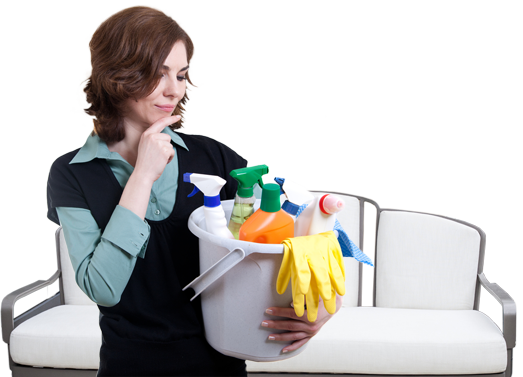Mold Prevention: Easy Steps for a Hygienic Bathroom
Posted on 21/09/2025
Mold Prevention: Easy Steps for a Hygienic Bathroom
Mold in the bathroom is a common headache for homeowners. Due to high humidity, frequent water usage, and limited ventilation, bathrooms become prime spots for mold growth. Not only does mold ruin the aesthetics, but it also poses health risks and structural damage. This comprehensive guide provides effective mold prevention techniques, ensuring your bathroom remains clean, fresh, and hygienic.
Understanding Mold: What Is It and Why Is It Harmful?
Mold is a type of fungus that thrives in moist and warm environments. It can form on surfaces like tiles, walls, ceilings, and even your personal belongings. Mold in bathrooms stands out because spores spread rapidly due to the consistent dampness. Apart from unsightly stains and bad odors, mold triggers allergies, respiratory problems, and weakens surfaces over time.
- Allergenic Effects: Mold spores cause sneezing, coughing, throat irritation, and worsen asthma symptoms.
- Structural Damage: Over time, mold degrades paint, grout, wallboards, and wood, risking costly repairs.
- Unpleasant Odors: Musty smells are often a sign of hidden mold colonies.
Knowing how to prevent mold formation in your bathroom is essential for your family's health and your home's value.

Mold Prevention Basics: The Key to a Hygienic Bathroom
Proactive mold prevention saves time, money, and frustration. Follow these easy steps for mold prevention in the bathroom to keep fungi at bay:
1. Control Humidity and Moisture
Moisture control is the most critical factor in preventing mold. Since bathrooms naturally get wet, managing the moisture level is imperative.
- Install Exhaust Fans: Ensure your bathroom fan is efficient and clean. Run it during baths/showers and for at least 20 minutes afterward.
- Open Windows: If possible, keep a window ajar while showering to allow steam to escape.
- Dry Wet Surfaces Promptly: Wipe down walls, mirrors, sinks, and bathtubs after use.
- Fix Leaks Immediately: Attend to dripping faucets, leaky pipes, and faulty toilet tanks as soon as you notice them.
- Use a Dehumidifier: For persistently damp bathrooms, consider a small dehumidifier to reduce ambient moisture.
2. Encourage Good Ventilation
Proper air flow is essential in stopping mold in bathrooms. Without it, condensation lingers, making a perfect home for mold spores.
- Leave Doors Open: After showering, keep the bathroom door open to facilitate faster drying.
- Position Vents Strategically: Ensure ventilation ducts are unblocked and aimed to maximize air circulation.
- Utilize Portable Fans: If your bathroom lacks built-in fans, set up a small portable fan to circulate air.
3. Clean Regularly and Deeply
Routine cleaning is pivotal to bathroom mold prevention. Mold feeds on soap residue, body oils, and grime. Regular removal starves potential colonies.
- Scrub Tiles and Grout: Use a mixture of baking soda and vinegar to tackle stubborn mildew. Commercial mold removers are also effective.
- Wash Shower Curtains: Fabric and plastic curtains are prone to mold buildup. Wash them every two weeks and replace when necessary.
- Clean Drains: Hair and debris in drains create a damp breeding ground. Use drain cleaners or vinegar and baking soda monthly.
- Wipe All Surfaces: Don't forget mirrors, faucets, light fixtures, and door handles.
4. Choose Mold-Resistant Materials
Construction and decor choices impact bathroom hygiene and mold resistance.
- Mold-Resistant Paint & Drywall: Use paints and wallboards labeled 'mold-inhibiting' or 'mildew-proof', especially on ceilings and poorly ventilated walls.
- Sealed Grout and Caulk: Reseal grout lines annually to prevent moisture penetration. Use silicone caulk for better water resistance.
- Non-Porous Surfaces: Install ceramic, porcelain, or glass tiles which are less likely to harbor mold than porous materials.
- Replace Old Fixtures: Swap out carpets or cloth mats for rubber or washable alternatives.
5. Reduce Clutter
Personal items left in the bathroom, such as shampoo bottles, loofahs, and towels, can retain water and hide mold on their undersides.
- Limit Shower Products: Store only essential toiletries and keep them elevated for air flow.
- Rotate Towels: Hang towels to dry between uses and launder them every 3-4 days.
- Organize Storage: Use closed cabinets and avoid stacking items on the floor or around the tub.
6. Inspect for Hidden Mold
Mold can lurk in places you rarely check. Regular inspections are vital for effective bathroom mold prevention.
- Check Under Sinks: Leaks and condensation beneath vanity units are prime mold zones.
- Behind Toilets: Condensation on pipes in winter months can result in mold growth and hidden puddles.
- Ceiling and Wall Corners: High up and in shadowy corners, moisture can condense and encourage fungi.
- Inside Cabinets: Dampness and poor air movement can create a perfect habitat for mold.
Smart Habits to Stop Bathroom Mold in Its Tracks
Establishing good daily habits delivers long-term results for mold control and bathroom hygiene. Here are smart routines you should incorporate:
- Shower with Cold Water First: Starting with a cold water spray for a few seconds before switching to hot can heat up tiles slower, reducing initial condensation.
- Squeegee After Each Use: Invest in a wall-mounted squeegee and draw it over tiles and glass doors post-shower to remove water quickly.
- Leave Bathmats Off the Floor: Hang or drape them over the tub or rails to dry thoroughly after each use.
- Keep Lids Off Hampers: Allow moist towels or clothes to air rather than retain humidity.
- Set Up a Cleaning Schedule: Assign specific days for deep cleans and stick to it. Consistency prevents buildup and mold recurrence.
Natural Solutions for Mold Prevention in the Bathroom
Many natural remedies are powerful allies in the battle against bathroom mold. Here are a few tried-and-tested eco-friendly solutions:
- Vinegar: Its acidity kills 82% of mold species. Fill a spray bottle with undiluted white vinegar, apply to problem areas, let sit for an hour, then wipe clean.
- Baking Soda: Mildly abrasive and odor-neutralizing, baking soda cleans tiles and grout safely. Sprinkle, scrub with water, rinse.
- Tea Tree Oil: Antifungal in nature. Add two teaspoons to two cups of water in a spray bottle, apply, let sit, and don't rinse.
- Lemon Juice: Natural bleaching and antibacterial properties make it effective. Spray lemon juice on affected zones and scrub lightly.
Note: Never mix ammonia-based cleaners with bleach. The fumes are hazardous.
What To Do If You Find Mold in Your Bathroom
If, despite your proactive mold prevention steps, you discover patches of mold, act quickly to limit its spread.
- Small Areas: Clean with commercial mold remover, vinegar, or a baking soda scrub. Wear gloves and a mask.
- Larger Colonies: For extensive growth--especially inside walls, ceiling boards, or HVAC--seek professional remediation. Mold may penetrate materials beyond the surface.
Always identify and fix the underlying moisture source, or colonies will return even after cleaning.
How to Prevent Mold in a Bathroom: Common Mistakes and How to Avoid Them
Even with the best intentions, certain oversights can undermine your mold control efforts. Avoid these pitfalls:
- Ignoring Ventilation: A common mistake is underestimating the importance of proper air flow. Don't neglect fan maintenance or airflow checkups.
- Relying Solely on Surface Cleaning: Visible mold isn't the only threat. Inspect and clean hidden spots regularly.
- Delaying Leak Repairs: Any water buildup, from even a slow drip, can trigger mold growth in just 24-48 hours.
- Skipping Grout Sealing: As grout ages, it becomes porous. Reseal annually for long-term protection.
- Storing Wet Products: Avoid keeping damp loofahs, washcloths, and bottles on surfaces--hang or remove them instead.

Benefits of Maintaining a Mold-Free Bathroom
Besides visual cleanliness, a mold-free bathroom delivers substantial advantages:
- Improved Indoor Air Quality: Less spore emission and reduced allergens.
- Healthier Environment: Prevents respiratory issues, irritation, and infections, especially in sensitive individuals.
- Lower Maintenance Costs: Prevents damage to paint, walls, flooring, and fixtures, reducing repairs.
- Enhanced Comfort and Hygiene: A sparkling bathroom boosts household well-being and confidence.
- Boosts Property Value: Homebuyers appreciate and pay more for homes with pristine, mold-free bathrooms.
Frequently Asked Questions About Mold Prevention in Bathrooms
Q: How often should I clean my bathroom to prevent mold?
A: Thoroughly clean all washable surfaces at least once a week. High-risk areas like grout and the shower should be cleaned more frequently if you have a household prone to humidity or with limited ventilation.
Q: What causes black mold in the bathroom?
A: Black mold (Stachybotrys chartarum) appears in areas with chronic moisture due to leaks, poor ventilation, and lack of cleaning. It's often found in grout, under sinks, or behind damp walls.
Q: Can I use bleach to remove mold?
A: Bleach is effective on non-porous surfaces, but not recommended for porous materials like drywall. Natural alternatives like vinegar or professional removal may be necessary for deep-seated mold.
Q: Are mold-resistant shower curtains worth it?
A: Yes. Mop-up-resistant curtains inhibit mildew growth and are easier to clean, playing an important role in mold prevention.
Q: Why does mold keep coming back?
A: Persistent mold indicates ongoing moisture problems. Check for leaks, review ventilation, and consider upgrading bathroom materials if needed.
Conclusion: A Fresh, Mold-Free Bathroom Is Achievable
With these easy steps for mold prevention in bathrooms, you can keep your bathroom spotless, safe, and pleasant. The keys are moisture management, adequate cleaning routines, and vigilance for leaks or ventilation issues. Make mold prevention a habit, and enjoy a hygienic bathroom that's inviting for everyone in your home. For severe issues, don't hesitate to consult a professional for advice or remediation. Protect your health and your home--start your mold prevention routine today!
Keywords: bathroom mold prevention, mold-free bathroom, stop mold in the bathroom, prevent bathroom mold, hygienic bathroom tips, reduce bathroom moisture, bathroom cleaning tips, healthy bathroom environment.




